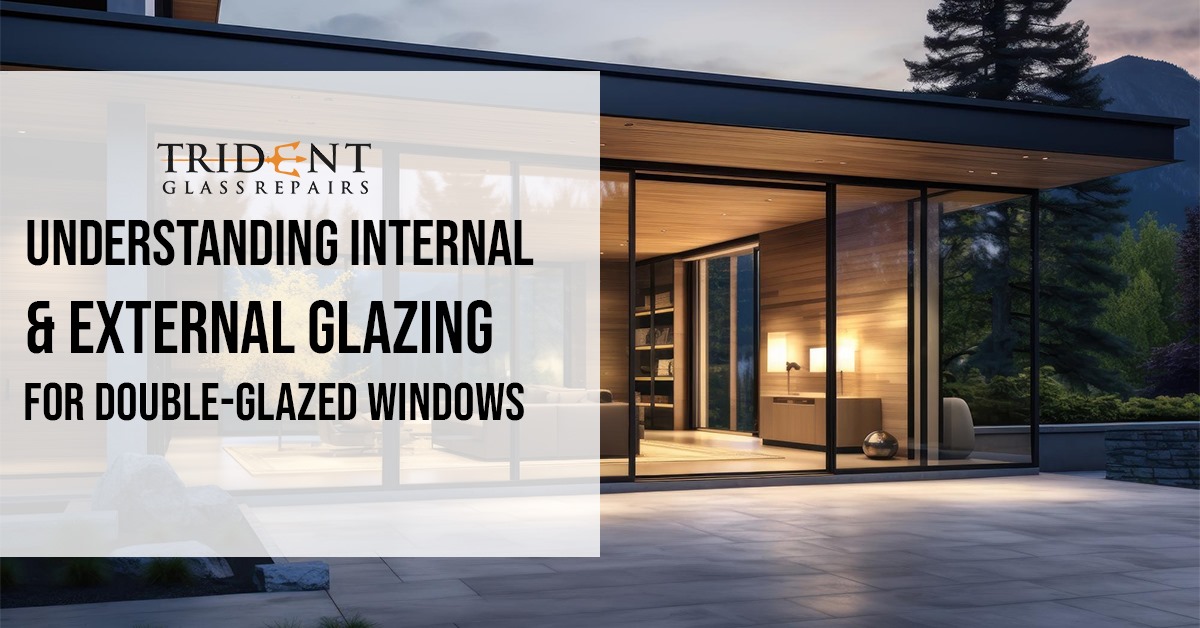Double-glazed windows have become increasingly popular in modern construction due to their numerous benefits, including improved insulation, energy efficiency, and soundproofing. One crucial aspect of double-glazed windows is the glazing, which can be categorized into internal and external glazing. In this blog Trident Glass Repairs explores what internal and external glazing entails, their differences, and their various insulation types.
What Is Double Glazing?
Before discussing internal and external glazing, let’s briefly define double glazing. Double glazing involves two panes of glass separated by a space filled with either air or gas, typically argon or krypton. This gap acts as insulation, reducing heat transfer and noise transmission, making double-glazed windows superior to single-pane windows in terms of thermal and acoustic performance. At Trident Glass Repair, we offer repairs, maintenance, and installation of double glazed windows Perth for enhanced energy efficiency and comfort for your home or business.
Internal Glazing:
Internal glazing refers to installing the secondary glass pane on the window frame’s inner side, facing the building’s interior. This configuration is commonly found in residential and commercial buildings and offers several advantages:
Enhanced Security:
Since the secondary glass pane is installed on the inner side, it provides an additional barrier against forced entry or breakage, enhancing security.
Ease Of Maintenance:
Internal glazing facilitates easier cleaning and maintenance as the exterior surface of the window remains untouched by external elements, such as dust, pollution, or weathering.
Aesthetic Appeal:
Internal glazing allows for various design possibilities, such as decorative glass options or tinted films, enhancing the interior space’s aesthetic appeal.
Weather Resistance:
By placing the secondary pane internally, it is shielded from harsh weather conditions, reducing the risk of damage or deterioration over time.
External Glazing:
External glazing, on the other hand, involves installing the secondary glass pane on the outer side of the window frame, facing the exterior of the building. While less common than internal glazing, it offers its own set of advantages:
Enhanced Insulation:
External glazing can provide slightly better thermal insulation, as the outer pane blocks direct heat transfer from the sun, mainly when low-emissivity coatings are applied.
Noise Reduction:
Placing the secondary pane on the exterior side helps reduce noise transmission from outside sources, making it beneficial for buildings in noisy environments.
Protection Against UV Radiation:
External glazing can offer better protection against UV radiation, preventing furniture, flooring, and interior fabrics from fading over time.
Condensation Control:
External glazing reduces the likelihood of condensation forming on the inner surface by keeping the outer pane cooler, minimizing moisture-related issues such as mold and mildew growth.
Insulation Option For External & Internal Double Glazing:
At Trident Glass Repairs, we offer the following insulation options for the windows with double glazing Perth.
Tinted Glass:
Tinted glass incorporates colorants into the glass during manufacturing to reduce the transmission of solar radiation and visible light. It can help control glare, reduce solar heat gain, and improve occupant comfort. Tinted glass provides moderate insulation benefits by blocking a portion of solar heat while still allowing natural light to enter the building.
Toughened Glass:
Toughened glass, also known as tempered glass, undergoes a specialized heat treatment process to increase its strength and resistance to impact. While toughened glass primarily enhances safety and durability, it also offers some insulation benefits due to its thickness and reduced likelihood of thermal breakage.
Laminated Glass:
Laminated glass consists of two or more glass panes bonded with an interlayer, usually Polyvinyl Butyral (PVB) or Ethylene-Vinyl Acetate (EVA). Laminated glass provides improved insulation by reducing noise transmission and enhancing security. The interlayer also acts as a barrier against heat transfer, contributing to better thermal performance.
Low-Emission (Low-E) Glass:
Low-E glass features a microscopically thin coating of metallic oxides applied to one or more glass surfaces during manufacturing. This coating selectively reflects infrared radiation while allowing visible light to pass through, resulting in improved insulation by reducing heat loss during winter and minimizing solar heat gain during summer.
Reflective (Mirrored) Glass:
Reflective or mirrored glass contains a metallic coating applied to one side of the glass surface. This coating reflects significant solar radiation, reducing solar heat gain and improving energy efficiency by keeping interior spaces cooler in hot climates.
Double Glazed Windows Perth | Glass Repair & Replacement Perth
Internal and external glazing are two approaches for double-glazed windows be it a installation or glass replacement Perth, each offering advantages and considerations. Approach Trident Glass Repairs for double glazing windows to enhance the comfort, energy efficiency, and functionality of buildings.









